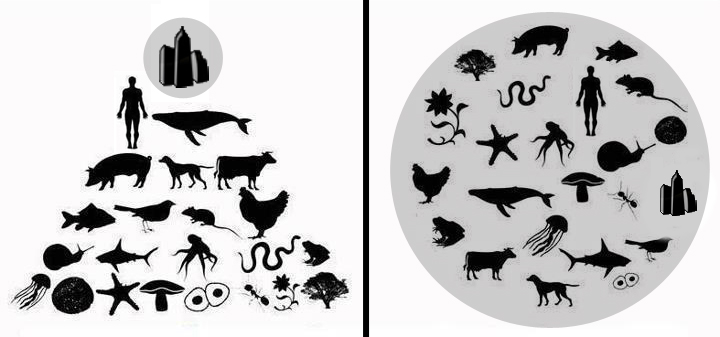<Tarzan in the Media Forest> – Toyo Ito
In the chapter ‘Learning from a Tree’, Toyo Ito starts with a demolition of a functional hospital building for a high rise construction for ‘economic development’. Albeit the disappointment he gathered three young ‘Tarzans’ to look into a possibility to establish a high rise structure that has a logical connection to the low rise surroundings by taking an example from the nature, a tree, that (a) has an inverted pyramid form that receives the maximum sunlight and allows a big public space on the ground level, (b) has a fractal form that repeats the geometry in a diminishing scale as it expands which blurs the inside/outside boundary, (c) is based on simple rules but composed in a complex order, (d) is not designed equivocally as it should only be clarified by various simulations, and (e) is open to the environment. Toyo Ito sees this way of thinking architecture (learning from a tree) as a chance to save ourselves from the deteriorating habitat.
Toyo Ito lists out three main points that have influenced his thinking as an architect in the 40 years that Japanese architecture had been influenced deeply by the economic and technological boom.
- While the development of technology finally managed to achieve the ‘dream of future cities’ of the architects, Toyo Ito, being one of them, saw the negative impact that collapsed his ‘future dream’. Instead of being benefited by the technology, the human are instead being dominated. Architecture has lost its value and importance in the technological era. As the technology brings people far from reality, architecture is no longer ‘creative’. He gives an example of a work of Kenzo Tange ‘House in White’, designed the extreme simplicity and tension, which he sees as a criticism of the society of that period, as ‘there is no future for architecture’.
- As Japan steps into a higher level of economic achievement, the value of land price has far transcended the value of architecture. Toyo Ito uses the word ‘intoxication’ to describe the society’s expectation to the idea of ‘city’. Architecture has become an empty structure that can be easily taken off and replaced. It is seen as an ‘abstraction’ in combination with ‘fiction’ that has an unprecedented level of transparency and lightness.
- Toyo Ito won the competition of the Mediatheque in Sendai. He claims that in the winning proposal he designed an extremely light structure with illogically thin elements, as he focused on obsessive beauty, abstraction and emptiness, which created an architecture with no architectural model (archetype) precedent. When it got to construction (reality) almost every element changed in terms of thickness and lightness that the real building looked completely different. People started to question the meaning and use of the building. With the never ending wonders the mediatheque remains ‘incomplete’ even after the finish of construction. Though the design has lost its ‘beauty’, it has been brought closer to the reality. The building has become his ultimately ideal architecture.
Toyo Ito expresses his aspiration to bring up young architects (Tarzans) in a way that they don’t rely exclusively on technology, as the way of thinking architecture should be reconciled with the nature (non-technology) . The development of technology should instead be used as a benefit to achieve the complex pattern of the nature, that has no boundary within each element. In this world of technology we as architects should not forget human as the reality, and always question ourselves about what we truly need in terms of architecture.
As a ‘Tarzan’ I genuinely agree with Toyo Ito’s view on the use of technology that has made us ‘inept’. We have lost the fundamental skills to achieve tasks.
Possible topic: As Toyo Ito mentions in the introduction the fractal geometry creates an ambiguous boundary of inside/outside, I would like to explore more on fractal forms of architecture that reconciles with the natural environment. In such way instead of standing on its own being disconnected with the other elements, architecture should be one of the various elements in the whole system, in which sustainability could only be achieved.

